When a business breaks the metaphorical seal on its new CRM system, things can go one of two ways.
It could be the moment that the entire business begins to discover the power of consistent data and buyer-centric operations. Or it could the moment that it starts to ruin that CRM, ensuring that in six months' time everyone hates it, blames it for all their problems and starts campaigning to get rid of it.
When you tear open your CRM system, there is no handbook. There are no guardrails. You are free to do precisely what you want to do. And that, is the problem. The freedom to do whatever you want, often leads to unnecessary complexity and confusion - the enemies of adoption and enjoyment.
Matters are made worse by the fact that few businesses put in the effort to learn how their CRM systems are supposed to be used, to document how their particular configuration works, or to train their users on them. Many just expect their people to know what to do.
Combine these two pitfalls and you have a sure-fire recipe for failure. So, how do you instead make sure that your new CRM becomes a linchpin in your organisation; showered with praise and admiration? Follow these CRM set-up best practices, that's how.
Best practices for CRM set-up
- Simplicity is king
- No more options than necessary
- Rely on provable fact
- Allow forward movement only
- Document and train
1. Simplicity is king
First, before we get on to the real, actionable advice, I want to implore you to always keep things as simple as possible. A big, hairy, complex CRM configuration doesn't make a better business. In fact, it can have the opposite effect.
People are sometimes startled when they see the simplicity of our approach to managing leads, deals and customers, but they are usually inspired when the see the ease with which we can report and the clarity of the results we can show.
Your CRM should be no more complex that your sales process and, ideally, much simpler. Introducing additional complexity to make it look impressive will just reduce everything that is actually important; adoption, enjoyment, speed, consistency, the list goes on.
2. No more options than absolutely necessary
When you are setting up anything in your CRM, limit the number of values, options, steps, etc, to the absolute bare minimum. The more choices your users have to make, the more room there is for confusion and error.
After working on hundreds of CRM configurations, CedarCone found that if a process has many steps or a property has many potential values, it is much more likely that users will either misunderstand, misinterpret or just misuse them, dashing your hopes of data consistency and quality on the rocks.
More choices also mean more screen is needed to see them - whereas information that we can see in full and at a glance is the easiest to interpret and act on. When a deal pipeline, for example, has so many stages that they run off screen, and can only be seen by scrolling back and forth over and over again, they become much harder to use.
3. Rely on provable fact
When configuring your CRM fields and properties, always use values the reflect verifiable fact.
The temptation to 'beef things up' and include or invent conditions that are impossible to know can be hard to resist. But you are not the buyer. You are not present in their meetings, privy to their internal conversations, or able to know exactly what's going on inside their heads. So don’t create a CRM that needs you to be.
Settings that are, in fact, impossible to know for sure require guesswork, assumption and interpretation to use. This often leads to movement back and fourth between states, depending on who's looking, and degrades the credibility and utility of your data.
Kyle Jepson of HubSpot makes the same recommendation in this in-depth article on selecting your deal stages - check it out.
4. Allow forward movement only
Most CRM configuration is aligned to a journey from a beginning state to an end state. But when that journey is not one-way, and potentially bidirectional, the data can't be relied on for decision making.
In their great post on configuring lead status, CedarCone suggest that a great way to improve the quality and consistency of CRM use is to, as much as possible, allow for forward movement only. Allowing forward movement only means creating values that once reached or passed, cannot be undone.
By allowing this forward movement only, there can be no ambiguity about the stage of a lead or the meaning of the data. This approach makes sense not only on the lead status property, but in almost all customisable CRM settings.
5. Document and train
If two things are missing from a lot of CRM deployments, they are documentation and training.
When a central team, or person, is responsible for configuring and customising the CRM to meet the needs of the business, the end-users need to understand what has been done and how it is intended to be used.
Training on the custom configurations and their use, as well as the CRM's basic functions, is therefore essential if you want to achieve a high level of data consistency and quality from the outset. Ideally, training wouldn't only be conducted at the point of CRM launch, but throughout adoption, to overcome human limitations when it comes to memorising information.
Documentation around the custom configuration and that is easily accessible by all users, in an internal knowledge base or wiki for example, acts as a useful reference that can be checked at any times of indecision, preventing mistakes before they happen.





